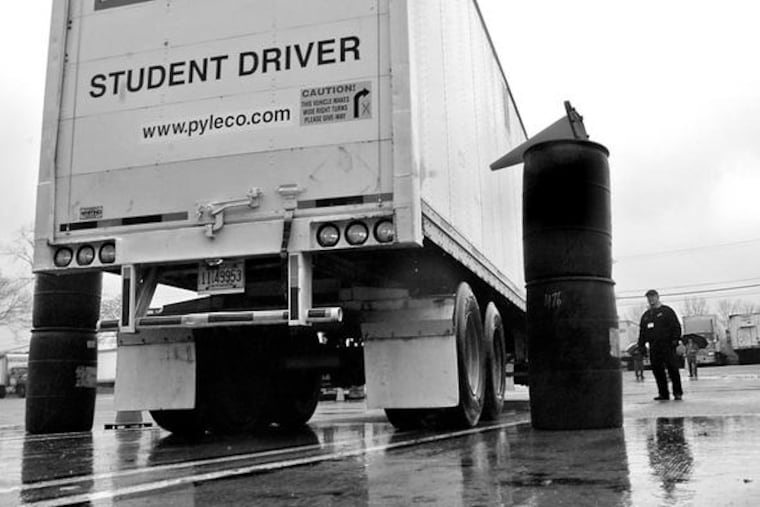Truckers in training: Driven to pursue a big-rig gig
After eight weeks of learning how to handle a big rig, John Uhrinek displayed a cool self-assurance as he began a maneuver known as "the jack and chase."

After eight weeks of learning how to handle a big rig, John Uhrinek displayed a cool self-assurance as he began a maneuver known as "the jack and chase."
The slim 23-year-old from Buffalo, N.Y., was one of four men enrolled in the truck-driving academy at the A. Duie Pyle company in West Chester.
The lettering on the side of his 48-foot box-trailer read STUDENT DRIVER.
With his elbow out of the cab's window, Uhrinek turned to look back at his target: two red cones spaced a few yards apart. He put the Mack tractor in reverse and, with nary a false start, backed the trailer between the cones - and right up to a loading dock. It fit like a snug plug in an outlet.
"These guys, they come here and they can't do anything," said Jim Cockerham, the school manager, watching in a cold rain last week. "Then, look at that: They make it look easy."
With the American economy in deep recession, Uhrinek and his trucker schoolmates are in better position than many people looking for a new line of work.
They are getting into a job that, while not always requiring a high school diploma, can pay $40,000 to $60,000 a year with experience - and comes with benefits, at least at a big company.
What's more, there's a shortage of people who seem to want the job, even these days.
In a 2005 study, the American Trucking Association found that the trucking industry needed 20,000 more qualified drivers than it could find. By 2014, it said, the shortfall could rise to 111,000.
"Given the state of the economy, that probably has eased somewhat for the short term," said Tiffany Wlazlowski, an association spokeswoman. "But we believe the shortage still stands for the long-term."
The legions of drivers now closing in on retirement came of age in the golden era of the trucker, when movies such as Smokey and the Bandit and country songs such as "Convoy" - Breaker one-nine, this here's the Rubber Duck - made the business seem thrilling and romantic.
But there were also some negative stereotypes. As George Herhei, a Pyle school instructor, told his class one day last week, truckers were depicted as men with the stub of a cigar in their teeth, a "be-bop hat" on their head and a "big, fat belly."
He told the class they were training to be business representatives who make a contract every time they sign a bill of lading and who are are responsible for tens of thousands of dollars in freight.
As he put it, Yogi Berra-style, "There's more to driving a truck than driving a truck."
At least two dozen schools in Pennsylvania - and nearly as many in New Jersey - offer courses preparing students to pass state exams for a commercial driver's license. Some truck companies, such as Pyle - which employs 850 drivers at 16 terminals in several states - run their own schools, imparting their own way of doing things.
The most recent Pyle course, which ended Friday, was smaller than some recent classes. Cockerham said the company likes to draw its students from the ranks of its own employees, often people working on its loading docks.
Uhrinek and two other trainees, both from North Jersey, were living at a Holiday Inn near West Chester while in the course. The fourth was a local man.
The 40 days of instruction included 40 hours on the road and 60 hours of driving around the yard at the Pyle company's terminal along Westtown Road. Instead of having to pay for their course, as at independent schools, the men drew their regular salaries. Cockerham said it costs the company about $20,000 to train each new driver.
Uhrinek said that there was "a lot to know."
For him, the hardest part was learning how much - and when - to apply the brakes.
That might sound easy, but a tractor-trailer and its contents can weigh up to 80,000 pounds. That's 40 tons.
"You have a lot of responsibility when you get into that vehicle," he said.
Ruben Torres, 30, of Carteret, N.J., said he found that changing gears was the hardest thing to catch on to.
Not only do the big rigs have nine gears, they have to be double-clutched - a tricky thing to learn.
Phillip Patterson, 34, of Elizabeth, N.J., said the task he found hardest was backing up a tractor-trailer, which can swing wildly, like an eel on a hook.
The father of two, a girl, 11, and a boy, 5, said that Smokey and the Bandit was a big influence when he was a boy in his wanting to be a truck driver. He was was only 5 when the movie came out, but - even now - it runs endlessly on cable.
"Fast cars and big trucks - it was something you wanted to do," he said.